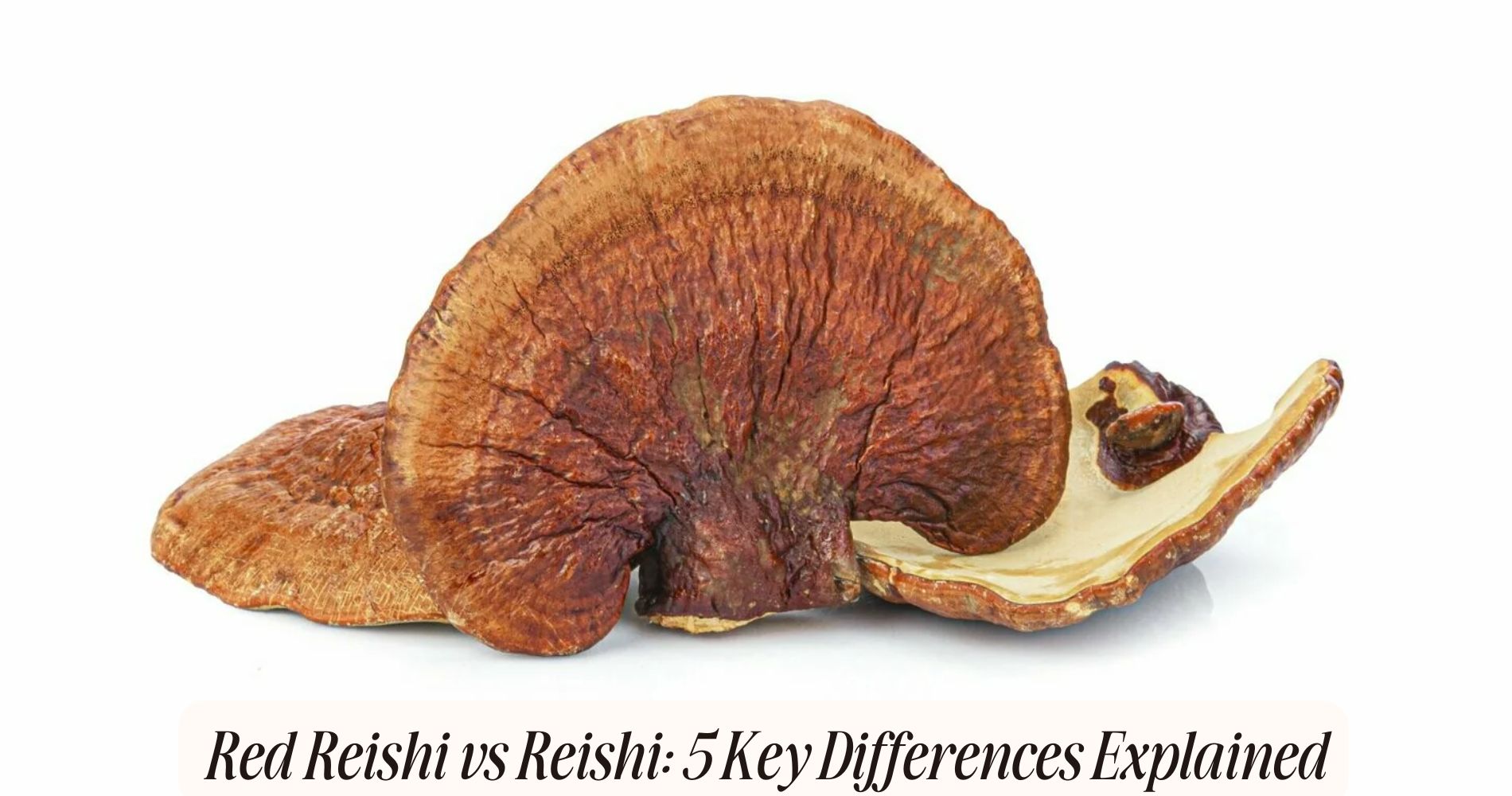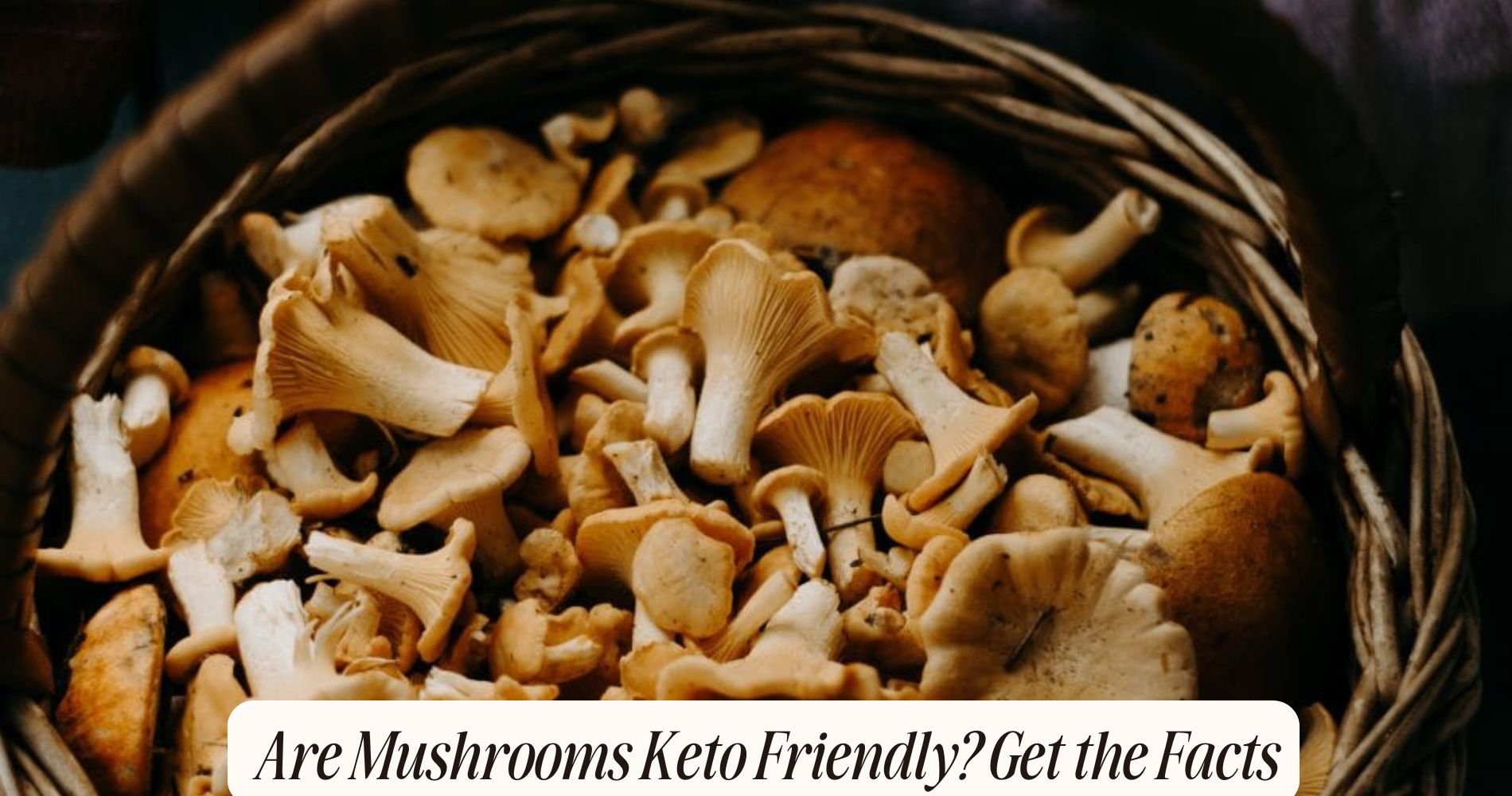
Red Reishi vs Reishi: 5 Key Differences Explained
When comparing Red Reishi and Traditional Reishi, you'll notice five key differences. First, Red Reishi boasts vibrant reddish-brown hues, while Traditional Reishi features muted shades of brown or gray. Nutritionally, Red Reishi has higher concentrations of beneficial compounds, making it more potent. Health-wise, Red Reishi excels in immune support and stress relief due to its adaptogenic properties. Culturally, Reishi has a rich history in East Asia, while Red Reishi is more accessible today. Finally, you'll find Red Reishi is often priced lower and readily available compared to its counterpart. Discover more distinctions about these fascinating mushrooms.
Appearance Comparison
When comparing the appearance of Red Reishi and traditional Reishi, you'll often notice distinct differences. Red Reishi, known scientifically as Ganoderma lucidum, typically exhibits vibrant, reddish-brown hues that catch the eye. These color variations can range from deep maroon to bright crimson, making it stand out in any herbal collection.
In contrast, traditional Reishi, or Ganoderma applanatum, showcases a more muted palette, often presenting in shades of light brown or gray, which can blend more easily with its surroundings.

Beyond color, texture differences also play a significant role in distinguishing these two types of Reishi. Red Reishi boasts a glossy, smooth surface that reflects light beautifully, enhancing its visual appeal. You might find it appears almost lacquered, giving it a polished look.
On the other hand, traditional Reishi typically features a more rugged, woody texture, often with a fibrous or porous quality. This roughness can create an earthy aesthetic, emphasizing its natural origins.
Nutritional Profiles
While the visual characteristics of Red Reishi and traditional Reishi offer a starting point for comparison, their nutritional profiles reveal even more significant differences that can impact your health choices.
Red Reishi tends to have a higher concentration of bioactive compounds, such as triterpenes and polysaccharides, compared to its traditional counterpart. These compounds are often associated with various health benefits, making the nutritional profile of Red Reishi particularly appealing.
When considering dosage recommendations, it's essential to recognize that the higher potency in Red Reishi may influence how much you should consume. Generally, lower doses may suffice for traditional Reishi due to its less concentrated compounds.
Moreover, the cultivation methods play a role in the nutritional content of both types. Red Reishi is often grown on specific substrates that enhance its nutrient profile, while traditional Reishi might be cultivated on different materials that yield varying results.
This aspect can impact not only potency but also the overall efficacy of the mushrooms. Understanding these nutritional differences can help you make more informed choices about which type of Reishi aligns best with your health goals.
Health Benefits
Exploring the health benefits of Red Reishi and traditional Reishi reveals distinct advantages that can greatly affect your well-being. Both types of Reishi are renowned for their potential to enhance immune support, but Red Reishi stands out due to its higher concentration of triterpenes, which are compounds known to bolster your immune system. This makes it particularly effective if you're looking to strengthen your body's defenses against illnesses.
In addition to immune support, Red Reishi is celebrated for its ability to provide stress relief. By promoting relaxation and reducing anxiety levels, this mushroom can help you manage the pressures of daily life more effectively. Its adaptogenic properties enable your body to adapt to stressors, which can lead to improved overall mental health.

While traditional Reishi also offers some immune-boosting benefits, it may not be as potent in stress relief as Red Reishi. If you're seeking a dual-action supplement that addresses both immune health and stress management, opting for Red Reishi could be your best bet.
Understanding these differences allows you to choose the right variant for your specific health goals.
Traditional Uses
Throughout history, Reishi mushrooms have been revered in traditional medicine for their wide-ranging applications. In various cultures, particularly in East Asia, they've held significant cultural importance, often seen as a symbol of longevity and liveliness. The historical context of Reishi use dates back thousands of years, particularly in Chinese medicine, where it's classified as a tonic for enhancing overall health and well-being.
You might be surprised to learn that these mushrooms were once considered so valuable that they were reserved for emperors and the elite. In traditional practices, practitioners utilized Reishi to address various ailments, including stress, insomnia, and immune system support. This historical reverence has contributed to its ongoing popularity in modern herbal medicine.
Moreover, the method of preparation has evolved, with traditional uses often involving teas or tinctures to harness their medicinal properties. The emphasis on holistic healing in various cultures has solidified Reishi's role in promoting balance and harmony within the body.
Understanding these traditional uses can deepen your appreciation for both Reishi and Red Reishi, illuminating how their historical significance continues to influence contemporary health practices.
Availability and Cost
Accessibility is a crucial factor when considering the use of Reishi and Red Reishi mushrooms. Both types have distinct availability and cost implications influenced by cultivation methods and market demand.
Traditional Reishi, known for its medicinal properties, is primarily grown in specific regions, often in controlled environments. This specialized cultivation method can lead to higher production costs, which are then reflected in retail prices.
Conversely, Red Reishi is typically cultivated more widely, thanks to its increasing popularity and market demand. This broader cultivation allows for competitive pricing, making Red Reishi more accessible to consumers.

You might find that while both mushrooms are available in various forms—powders, capsules, and teas—Red Reishi often has a more consistent supply chain due to its cultivation adaptability. As a result, you may notice that Red Reishi products tend to be more affordable and easier to find in stores or online.
Ultimately, if you're considering incorporating either Reishi or Red Reishi into your wellness routine, it's important to evaluate both availability and cost, ensuring you make an informed decision based on your budget and accessibility needs.
Unlock Daily Wellness with Well Gummies' Ultimate Wellness Bundle
For a simple and delicious way to enjoy the benefits of mushrooms, try Well Gummies' Ultimate Wellness Bundle. This easy-to-use gum chew product includes All-in-One Mushroom Gummies for everyday health and Lion's Mane Focus and Energy Gummies for when you need an extra boost. With 10 types of mushrooms, these vegan gummies naturally fuel your brain, enhance focus, and support immune health—all with a delightful wild berry flavor. No jitters, no crash—just calm, steady energy to keep you feeling your best throughout the day!
Frequently Asked Questions
Are There Any Side Effects of Consuming Red Reishi?
When consuming red reishi, some might experience side effects like digestive issues or allergic reactions. To enjoy red reishi benefits, stick to recommended dosages, as excessive intake can increase the likelihood of adverse effects.
How Do Red Reishi and Reishi Taste Compared to Each Other?
When you compare the flavor profiles, red reishi tends to have a slightly bitter taste, while regular reishi offers an earthy, woody flavor. Both mushrooms have unique culinary uses, enhancing broths and herbal teas effectively.
Can I Grow Red Reishi at Home?
You can grow red reishi at home, but you'll need specific growing conditions like humidity and temperature. Mastering harvesting techniques is essential for ideal yield, ensuring you maximize your investment in time and resources.
What Is the Best Way to Prepare Reishi Mushrooms?
The best way to prepare reishi mushrooms involves mushroom extraction methods like boiling or simmering. You can incorporate these into various reishi recipes, enhancing their health benefits while ensuring a rich, earthy flavor in your dishes.
Are There Any Known Interactions With Medications for Red Reishi?
You should consult your healthcare provider about potential interactions with medications when considering red reishi. While red reishi offers benefits, proper dosage is essential to avoid adverse effects or complications with existing treatments.
Conclusion
Ultimately, while red reishi and traditional reishi may seem similar, their differences in appearance, nutritional profiles, health benefits, traditional uses, and availability highlight their unique qualities. Understanding these distinctions can help you make informed choices based on your health goals and preferences. Whether you opt for red reishi or its counterpart, both offer valuable benefits that can enhance your wellness journey. Choose wisely to maximize the advantages each type provides for your health.




